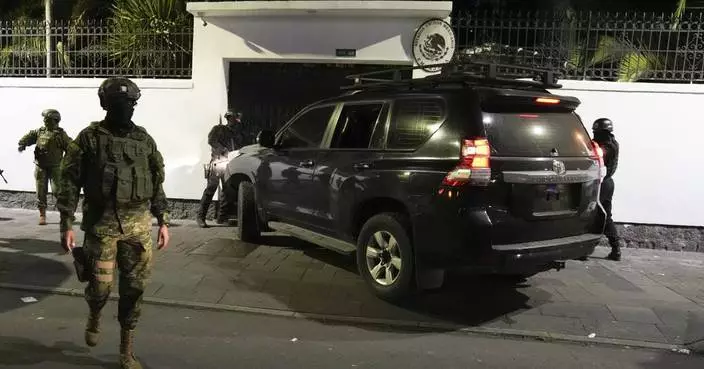The U.N. envoy for Yemen urged the warring parties Wednesday to maintain the momentum of the initial pullout of Houthi rebel forces from three ports by moving quickly to larger joint withdrawals — and to work urgently on a political solution to the devastating conflict.
Martin Griffiths told the Security Council there are "signs of hope" but also "alarming signs in recent days" that progress can be threatened, noting that war often trumps peace.
He pointed to an escalation of violence in Yemen's southern Dhale province, which had been under the control of forces loyal to the internationally recognized government. He also expressed serious concern at news of a drone attack Tuesday on oil facilities in neighboring Saudi Arabia, saying "we cannot ignore how these developments affect the political process."
The conflict in Yemen began with the 2014 takeover of the capital, Sanaa, by the Iran-backed Houthis. A Saudi-led coalition allied with the internationally recognized government has been fighting the Houthis since 2015.
The fighting in the Arab world's poorest country has killed thousands of civilians, left millions suffering from food and medical care shortages and pushed the country to the brink of famine.
"Yemen remains at the crossroads between war and peace," Griffiths said, despite the significance of the U.N.-monitored Houthi withdrawals from the key port of Hodeida and the smaller ports of Salif and Ras Issa between May 11-14. The port at Hodeida handles about 70 percent of Yemen's commercial and humanitarian imports.
He said the withdrawals must be followed by "concrete actions" by the government and the Houthis to deliver on their commitments to further redeployments under the agreement signed in Sweden in December.
A U.N. official has said the first phase of redeployment involves a pullback of several kilometers (miles) by the Houthis and coalition forces, and the second phase involves a withdrawal of 18 to 30 kilometers (11 to 18 1/2 miles), depending on the location and fighters.
Both sides have agreed on the operational plan for phase one and Griffiths urged them to agree on the plan for phase two.
He urged the Security Council to welcome the redeployments, urge the parties to work quickly to implement the remaining withdrawals, and work urgently with the U.N. on a political solution.
"These beginnings, these early shoots, must be protected from the threat of war," Griffiths said. "We must not allow war to take peace off the table."
U.N. humanitarian chief Mark Lowcock told the council that 10 million Yemenis are relying on food assistance to survive and "the specter of famine still looms."
A resurgent cholera outbreak has affected 300,000 people so far this year — compared to 370,000 during all of 2018, he said.
Henrietta Fore, head of the U.N. children's agency UNICEF, told the council that since the fighting began in Yemen four years ago, 7,300 children have been killed or injured, and the numbers are no doubt higher because these are verified numbers.
She said 360,000 children are suffering from severe acute malnutrition and half the children under the age of five — 2.5 million — are stunted, "and stunting is irreversible."
"Yemen is spiraling perilously close to the brink," Fore said.
She urged the parties to agree to "days of tranquility" to vaccinate children — and to enable 15 million Yemeni children to live in peace.
UNITED NATIONS (AP) — The world hasn’t seen anything like the unprecedented destruction of housing in Gaza since World War II, and it would take at least until 2040 to restore the homes devastated in Israel’s bombing and ground offensive if the conflict ended today, the United Nations reported Thursday.
The U.N. assessment said the social and economic impact of the war launched after Hamas’ surprise attack in southern Israel on Oct. 7 has been increasing “in an exponential manner.”
It called the level of casualties – 5% of Gaza’s 2.3 million population -- “unprecedented” in such a short time. By mid-April, it said, over 33,000 Palestinians had been killed and more than 80,000 injured. About 7,000 others remain missing, most believed to be buried under the rubble.
“Every additional day that this war continues is exacting huge and compounding costs to Gazans and all Palestinians” said United Nations Development Program Administrator Achim Steiner.
The report by UNDP and the U.N. Economic Commission for Western Asia paints a dire picture of the struggle to survive in Gaza where 201,000 jobs have been lost since the war began and the economy contracted 81% in the last quarter of 2023.
Abdallah Al Dardari, UNDP’s regional director for Arab states, told a U.N. press conference launching the report that almost $50 billion in investments in Gaza are estimated to have been wiped out in the conflict, and 1.8 million Palestinians have fallen into poverty.
Gaza has been under blockade by Israel and Egypt since Hamas’ 2007 takeover, putting tight controls on what enters and exits the territory. Even before the war, it faced “hyper-unemployment” of 45%, reaching nearly 63% among younger workers.
According to the report, the U.N. Human Development Index – which measures key issues for a long and healthy life, for gaining knowledge and for achieving a decent standard of living – has been pushed back more than 20 years in Gaza.
The “productive basis of the economy has been destroyed,” the report said, with sectors experiencing losses of more than 90%. It estimated that the GDP of Gaza could decrease by 51% in 2024.
“The scope and scale of damages have been unprecedented and still mounting as the war still rages on,” it said.
At least 370,000 housing units in Gaza have been damaged, including 79,000 destroyed completely, the report said, along with commercial buildings.
After previous Israel-Hamas conflicts, housing was rebuilt at a rate of 992 units a year, it said. Even if Israel allows a five-fold increase of construction material to enter Gaza, it would take until 2040 to rebuild the destroyed houses, without repairing the damaged ones.
Al Dardari said that after 51 days of fighting between Israel and Hamas in 2014 there were 2.4 million tons of debris in Gaza. In the current war, he said, there are already 37 tons of debris that need to be removed to make space for temporary shelters and other structures which are critical to return some sort of normalcy to Palestinians in Gaza.
“We haven't seen anything like this since 1945, since the Second World War — that intensity in such a short time, and the massive scale of destruction,” he said.
Al Dardari said the preliminary estimate of the cost of an early recovery program for three years, which would bring hundreds of thousands of Palestinians back to temporary shelters in their original locations with community support, is between $2 billion and $3 billion.
The rough estimate for the overall reconstruction of Gaza is between $40 billion and $50 billion, he said.
But Al Dardari stressed that the immediate focus now is on planning for early recovery.
He said the U.N. senior humanitarian and reconstruction coordinator for Gaza, Sigrid Kaag, and other officials met earlier Thursday with 22 U.N. agencies and went through plans by each one for the initial years after the war ends.
“We are on the verge of developing and finalizing a unified view and early recovery framework that is Palestinian-centered, Palestinian-led and owned by the Palestinian people,” Al Dardari said.
Associated Press Writer Lee Keath contributed to this report from Cairo

The unprecedented destruction of housing in Gaza hasn't been seen since World War II, the UN says

The unprecedented destruction of housing in Gaza hasn't been seen since World War II, the UN says

Palestinians look at the destruction after an Israeli airstrike in Deir al Balah, Gaza Strip, Tuesday, April 30, 2024. (AP Photo/Abdel Kareem Hana)












